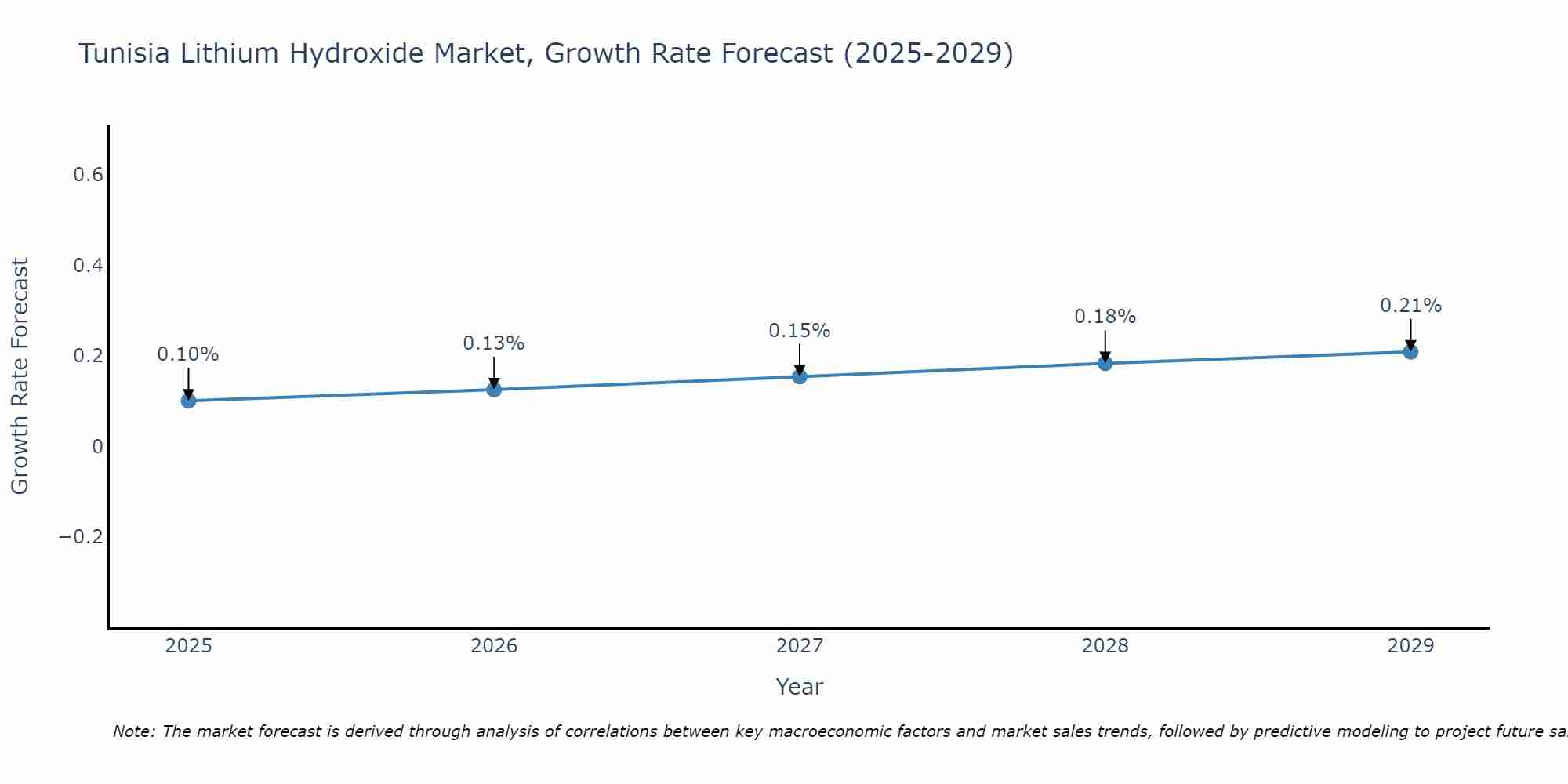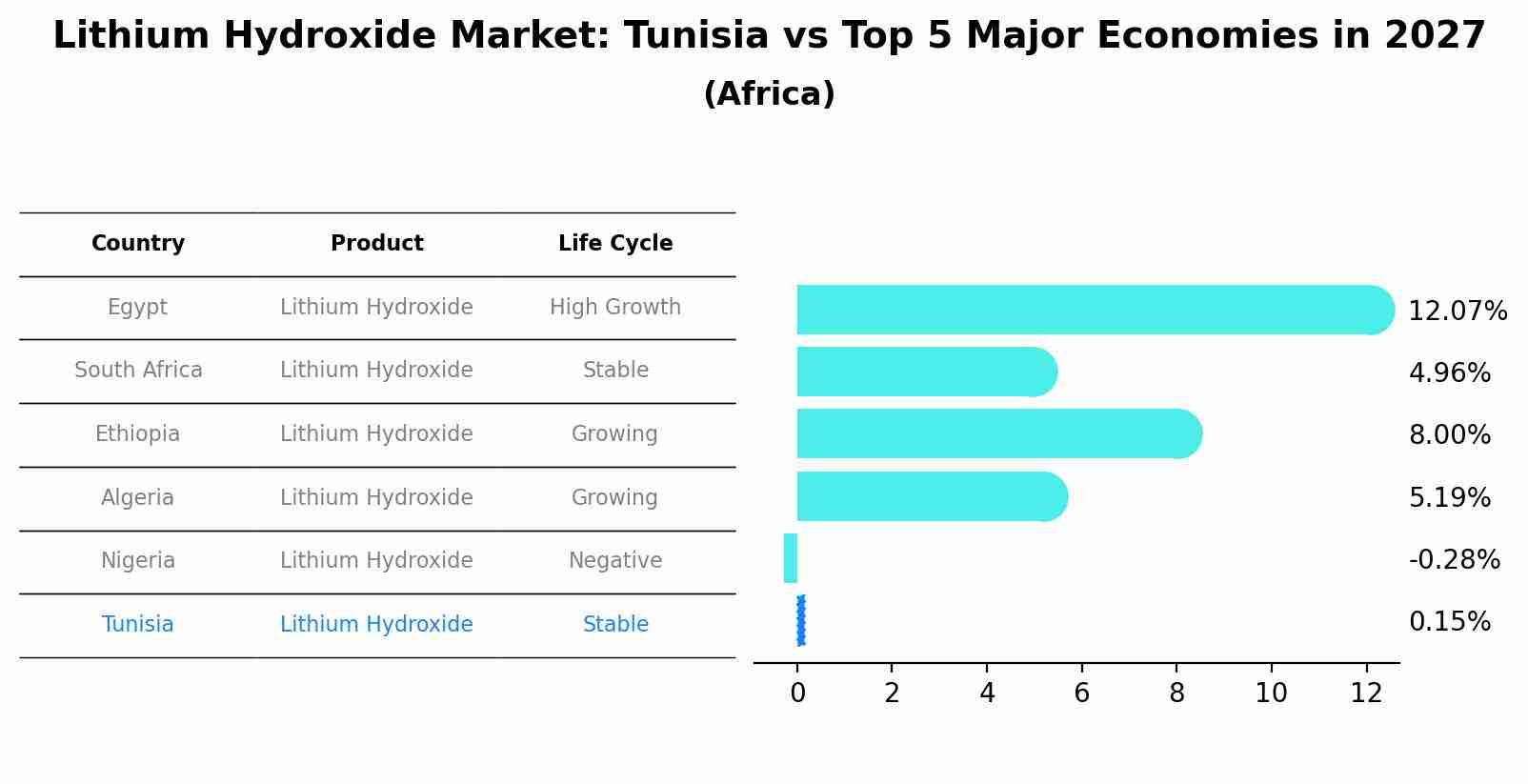Tunisia Lithium Hydroxide Market (2025-2031) Outlook | Companies, Share, Analysis, Size, Growth, Forecast, Revenue, Trends, Industry & Value
| Product Code: ETC195306 | Publication Date: May 2022 | Updated Date: Aug 2025 | Product Type: Market Research Report | |
| Publisher: 6Wresearch | Author: Ravi Bhandari | No. of Pages: 60 | No. of Figures: 40 | No. of Tables: 7 |
Tunisia Lithium Hydroxide Market Size Growth Rate
The Tunisia Lithium Hydroxide Market is likely to experience consistent growth rate gains over the period 2025 to 2029. From 0.10% in 2025, the growth rate steadily ascends to 0.21% in 2029.

Lithium Hydroxide Market: Tunisia vs Top 5 Major Economies in 2027 (Africa)
By 2027, Tunisia's Lithium Hydroxide market is forecasted to achieve a stable growth rate of 0.15%, with Egypt leading the Africa region, followed by South Africa, Ethiopia, Algeria and Nigeria.

Tunisia Lithium Hydroxide Market Overview
In Tunisia, the lithium hydroxide market is witnessing growth with chemical compounds used in lithium-ion battery cathodes, ceramics, and lubricants, focusing on purity, particle size distribution, and environmental sustainability in production processes. Market dynamics include electric vehicle (EV) battery technologies, energy storage solutions, and investments in lithium hydroxide refining capabilities. The market serves battery materials suppliers, automotive OEMs, and electronics manufacturers seeking reliable sources of high-purity lithium hydroxide for advanced energy applications.
Drivers of the market
The Tunisia lithium hydroxide market is driven by battery manufacturing, renewable energy storage, and demand for high-purity lithium hydroxide in lithium-ion batteries. Lithium hydroxide serves as a critical component for cathode materials, enhancing battery performance, energy efficiency, and cycle life. The market benefits from advancements in electric vehicle (EV) adoption, grid-scale energy storage projects, and technological innovations in battery chemistry. Moreover, regulatory support for clean energy initiatives, strategic alliances in battery supply chains, and investments in sustainable mining practices are shaping market dynamics in Tunisia.
Challenges of the market
The lithium hydroxide market in Tunisia faces challenges associated with production costs and market demand dynamics. Limited local production capacity for lithium hydroxide impacts supply chain efficiency and pricing strategies. Moreover, price volatility in raw material costs and competitive pressures from global suppliers influence market positioning and profitability for local manufacturers. Regulatory compliance for chemical production standards and environmental sustainability further adds complexity to market operations and product development strategies, influencing industry growth and market expansion.
Government Policy of the market
Government policies in Tunisia regarding the lithium hydroxide market focus on incentivizing domestic production through tax incentives and subsidies for research and development. The government aims to attract foreign investment to enhance mining and processing capabilities, thereby fostering growth in the lithium hydroxide sector.
Key Highlights of the Report:
- Tunisia Lithium Hydroxide Market Outlook
- Market Size of Tunisia Lithium Hydroxide Market, 2024
- Forecast of Tunisia Lithium Hydroxide Market, 2031
- Historical Data and Forecast of Tunisia Lithium Hydroxide Revenues & Volume for the Period 2021-2031
- Tunisia Lithium Hydroxide Market Trend Evolution
- Tunisia Lithium Hydroxide Market Drivers and Challenges
- Tunisia Lithium Hydroxide Price Trends
- Tunisia Lithium Hydroxide Porter's Five Forces
- Tunisia Lithium Hydroxide Industry Life Cycle
- Historical Data and Forecast of Tunisia Lithium Hydroxide Market Revenues & Volume By Application for the Period 2021-2031
- Historical Data and Forecast of Tunisia Lithium Hydroxide Market Revenues & Volume By Batteries for the Period 2021-2031
- Historical Data and Forecast of Tunisia Lithium Hydroxide Market Revenues & Volume By Lubricating Greases for the Period 2021-2031
- Historical Data and Forecast of Tunisia Lithium Hydroxide Market Revenues & Volume By Purification for the Period 2021-2031
- Historical Data and Forecast of Tunisia Lithium Hydroxide Market Revenues & Volume By Others for the Period 2021-2031
- Tunisia Lithium Hydroxide Import Export Trade Statistics
- Market Opportunity Assessment By Application
- Tunisia Lithium Hydroxide Top Companies Market Share
- Tunisia Lithium Hydroxide Competitive Benchmarking By Technical and Operational Parameters
- Tunisia Lithium Hydroxide Company Profiles
- Tunisia Lithium Hydroxide Key Strategic Recommendations
Frequently Asked Questions About the Market Study (FAQs):
1 Executive Summary |
2 Introduction |
2.1 Key Highlights of the Report |
2.2 Report Description |
2.3 Market Scope & Segmentation |
2.4 Research Methodology |
2.5 Assumptions |
3 Tunisia Lithium Hydroxide Market Overview |
3.1 Tunisia Country Macro Economic Indicators |
3.2 Tunisia Lithium Hydroxide Market Revenues & Volume, 2021 & 2031F |
3.3 Tunisia Lithium Hydroxide Market - Industry Life Cycle |
3.4 Tunisia Lithium Hydroxide Market - Porter's Five Forces |
3.5 Tunisia Lithium Hydroxide Market Revenues & Volume Share, By Application, 2021 & 2031F |
4 Tunisia Lithium Hydroxide Market Dynamics |
4.1 Impact Analysis |
4.2 Market Drivers |
4.2.1 Increasing demand for lithium-ion batteries in various industries such as automotive, electronics, and energy storage. |
4.2.2 Growing focus on sustainable energy solutions leading to higher adoption of electric vehicles and renewable energy storage systems. |
4.2.3 Government initiatives and incentives promoting the use of electric vehicles and renewable energy sources. |
4.3 Market Restraints |
4.3.1 High initial investment required for establishing lithium hydroxide production facilities. |
4.3.2 Limited availability of lithium resources in Tunisia, leading to dependency on imports. |
4.3.3 Fluctuating prices of lithium in the global market impacting the cost of production. |
5 Tunisia Lithium Hydroxide Market Trends |
6 Tunisia Lithium Hydroxide Market, By Types |
6.1 Tunisia Lithium Hydroxide Market, By Application |
6.1.1 Overview and Analysis |
6.1.2 Tunisia Lithium Hydroxide Market Revenues & Volume, By Application, 2021-2031F |
6.1.3 Tunisia Lithium Hydroxide Market Revenues & Volume, By Batteries, 2021-2031F |
6.1.4 Tunisia Lithium Hydroxide Market Revenues & Volume, By Lubricating Greases, 2021-2031F |
6.1.5 Tunisia Lithium Hydroxide Market Revenues & Volume, By Purification, 2021-2031F |
6.1.6 Tunisia Lithium Hydroxide Market Revenues & Volume, By Others, 2021-2031F |
7 Tunisia Lithium Hydroxide Market Import-Export Trade Statistics |
7.1 Tunisia Lithium Hydroxide Market Export to Major Countries |
7.2 Tunisia Lithium Hydroxide Market Imports from Major Countries |
8 Tunisia Lithium Hydroxide Market Key Performance Indicators |
8.1 Average selling price of lithium hydroxide in Tunisia. |
8.2 Percentage of lithium hydroxide production capacity utilized in the country. |
8.3 Research and development investment in lithium battery technology advancement. |
8.4 Percentage of electric vehicles in the total automotive market in Tunisia. |
9 Tunisia Lithium Hydroxide Market - Opportunity Assessment |
9.1 Tunisia Lithium Hydroxide Market Opportunity Assessment, By Application, 2021 & 2031F |
10 Tunisia Lithium Hydroxide Market - Competitive Landscape |
10.1 Tunisia Lithium Hydroxide Market Revenue Share, By Companies, 2024 |
10.2 Tunisia Lithium Hydroxide Market Competitive Benchmarking, By Operating and Technical Parameters |
11 Company Profiles |
12 Recommendations |
13 Disclaimer |
- Single User License$ 1,995
- Department License$ 2,400
- Site License$ 3,120
- Global License$ 3,795
Search
Thought Leadership and Analyst Meet
Our Clients
Related Reports
- Canada Oil and Gas Market (2026-2032) | Share, Segmentation, Value, Industry, Trends, Forecast, Analysis, Size & Revenue, Growth, Competitive Landscape, Outlook, Companies
- Germany Breakfast Food Market (2026-2032) | Industry, Share, Growth, Size, Companies, Value, Analysis, Revenue, Trends, Forecast & Outlook
- Australia Briquette Market (2025-2031) | Growth, Size, Revenue, Forecast, Analysis, Trends, Value, Share, Industry & Companies
- Vietnam System Integrator Market (2025-2031) | Size, Companies, Analysis, Industry, Value, Forecast, Growth, Trends, Revenue & Share
- ASEAN and Thailand Brain Health Supplements Market (2025-2031) | Strategy, Consumer Insights, Analysis, Investment Trends, Opportunities, Growth, Size, Share, Industry, Revenue, Segments, Value, Segmentation, Supply, Forecast, Restraints, Outlook, Competition, Drivers, Trends, Demand, Pricing Analysis, Competitive, Strategic Insights, Companies, Challenges
- ASEAN Bearings Market (2025-2031) | Strategy, Consumer Insights, Analysis, Investment Trends, Opportunities, Growth, Size, Share, Industry, Revenue, Segments, Value, Segmentation, Supply, Forecast, Restraints, Outlook, Competition, Drivers, Trends, Demand, Pricing Analysis, Competitive, Strategic Insights, Companies, Challenges
- Europe Flooring Market (2025-2031) | Outlook, Share, Industry, Trends, Forecast, Companies, Revenue, Size, Analysis, Growth & Value
- Saudi Arabia Manlift Market (2025-2031) | Outlook, Size, Growth, Trends, Companies, Industry, Revenue, Value, Share, Forecast & Analysis
- Uganda Excavator, Crane, and Wheel Loaders Market (2025-2031) | Strategy, Consumer Insights, Analysis, Investment Trends, Opportunities, Growth, Size, Share, Industry, Revenue, Segments, Value, Segmentation, Supply, Forecast, Restraints, Outlook, Competition, Drivers, Trends, Demand, Pricing Analysis, Competitive, Strategic Insights, Companies, Challenges
- Rwanda Excavator, Crane, and Wheel Loaders Market (2025-2031) | Strategy, Consumer Insights, Analysis, Investment Trends, Opportunities, Growth, Size, Share, Industry, Revenue, Segments, Value, Segmentation, Supply, Forecast, Restraints, Outlook, Competition, Drivers, Trends, Demand, Pricing Analysis, Competitive, Strategic Insights, Companies, Challenges
Industry Events and Analyst Meet
Whitepaper
- Middle East & Africa Commercial Security Market Click here to view more.
- Middle East & Africa Fire Safety Systems & Equipment Market Click here to view more.
- GCC Drone Market Click here to view more.
- Middle East Lighting Fixture Market Click here to view more.
- GCC Physical & Perimeter Security Market Click here to view more.
6WResearch In News
- Doha a strategic location for EV manufacturing hub: IPA Qatar
- Demand for luxury TVs surging in the GCC, says Samsung
- Empowering Growth: The Thriving Journey of Bangladesh’s Cable Industry
- Demand for luxury TVs surging in the GCC, says Samsung
- Video call with a traditional healer? Once unthinkable, it’s now common in South Africa
- Intelligent Buildings To Smooth GCC’s Path To Net Zero


















